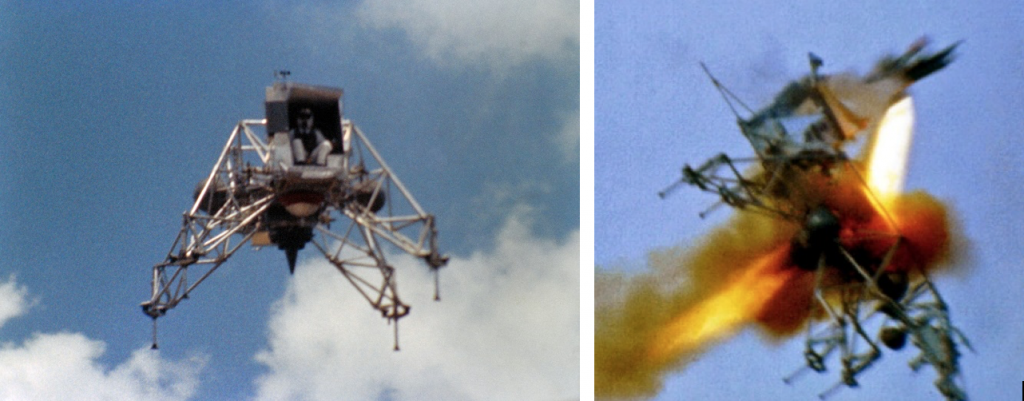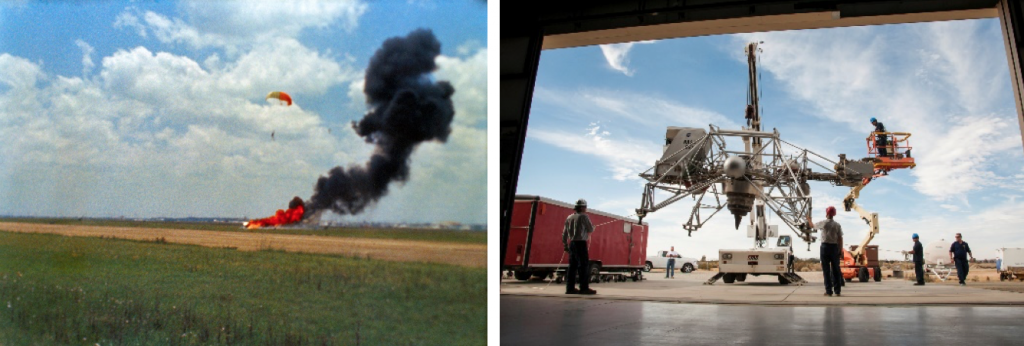By Wes O’Donnell
Managing Editor of In Military, InCyberDefense and In Space News.
Described by astronaut Bill Anders as “the unsung hero of the Apollo Program” in Neil Armstrong’s biography “First Man,” the Lunar Landing Research Vehicle (LLRV) was essential in preparing astronauts for landing on the Moon.
On May 6, 1968, astronaut Neil A. Armstrong, then assigned as backup commander for the Apollo 9 mission, took off on a simulated lunar landing mission in LLRV-1 from Ellington Air Force Base in Houston on his 22nd flight of the test vehicle.
Get started on your Space Studies Degree at American Military University. |
According to NASA, “Armstrong had been airborne about five minutes when he suddenly lost control of the vehicle. About 200 feet above the ground, he chose to eject. While the LLRV crashed and burned on impact, Armstrong parachuted safely to Earth and was not injured.”
Astronaut Neil Armstrong flying LLRV-1 at Ellington AFB shortly before the crash (left) and ejecting from the vehicle just seconds before it crashed (right). Courtesy NASA/JPL
A crash investigation determined that a loss of helium pressure caused depletion of the hydrogen peroxide used for the reserve attitude thrusters. Unfortunately, the vehicle’s instrumentation did not provide adequate warning.
Engineers corrected the problem and flights resumed in October of that year.
Specifications (LLRV):
General characteristics
- Crew: 1
- Length: 22 ft 6 in (6.85 m)
- Width: 15 ft 1 in (4.6 m)
- Height: 10 ft 0 in (3.05 m)
- Empty weight: 2,510 lb (1,139 kg)
- Gross weight: 3,775 lb (1,712 kg)
- Max takeoff weight: 3,925 lb (1,780 kg)
- Powerplant: 1 × General Electric CF700-2V turbofan (aft-fan CJ610), 4,200 lbf (19 kN) thrust
- Powerplant: 2 × Hydrogen Peroxide rocket engines, 100 lbf (0.44 kN) thrust each to 500 lbf (2,200 N) throttleable
- Powerplant: 6 × solid-fuelled rocket engines, 500 lbf (2.2 kN) thrust each safety standby engines
Performance
- Maximum speed: 35 kn (40 mph, 65 km/h)
- Endurance: 10 minutes
- Service ceiling: 6,000 ft (1,800 m)
- Rate of climb: 3,600 ft/min (18 m/s)
- Thrust/weight: 1.07
LLRV-2 is on display at the Air Force Flight Test Museum at Edwards Air Force Base (on loan from Armstrong Flight Research Center).
Armstrong parachuting to safety after ejecting from LLRV-1 which is seen burning on the ground after its crash (left). LLRV-2 being moved from Armstrong Flight Research Center for display at the Air Force Test Flight Museum at Edwards Air Force Base (right). Courtesy NASA/JPL



Comments are closed.